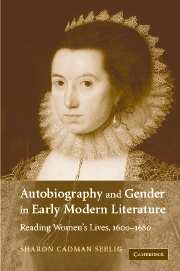Book contents
- Frontmatter
- Contents
- Preface
- Introduction: mapping the territory
- 1 Margaret Hoby: the stewardship of time
- 2 The construction of a life: the diaries of Anne Clifford
- 3 Pygmalion's image: the lives of Lucy Hutchinson
- 4 Ann Fanshawe: private historian
- 5 Romance and respectability: the autobiography of Anne Halkett
- 6 Margaret Cavendish: shy person to Blazing Empress
- Conclusion: “The Life of Me”
- Notes
- Bibliography
- Index
2 - The construction of a life: the diaries of Anne Clifford
Published online by Cambridge University Press: 22 September 2009
- Frontmatter
- Contents
- Preface
- Introduction: mapping the territory
- 1 Margaret Hoby: the stewardship of time
- 2 The construction of a life: the diaries of Anne Clifford
- 3 Pygmalion's image: the lives of Lucy Hutchinson
- 4 Ann Fanshawe: private historian
- 5 Romance and respectability: the autobiography of Anne Halkett
- 6 Margaret Cavendish: shy person to Blazing Empress
- Conclusion: “The Life of Me”
- Notes
- Bibliography
- Index
Summary
The diaries and personal records of Anne Clifford are not only more extensive than those of Margaret Hoby, covering over thirty years of her life, but also more varied in genre, style, and approach, and far more deliberately constructed. Taken together they constitute a remarkable account of a life lived, observed, and carefully presented in written form; they manifest strong and characteristic themes and an often painful tension between personal relationships and dynastic claims. I want to consider how Anne Clifford understood what she was doing, what purpose she intended these records to serve, and what the limits of interpretation might be. While these texts of course supply information about Clifford's life, the conclusions about her character and intentions that have been drawn from them vary widely. But as before I am less concerned with information per se than with more formal aspects of the text as they create meaning, and with the experience of reading, an experience that is considerably more complex and nuanced than any summary might suggest.
Anne Clifford, daughter of George Clifford, third Earl of Cumberland, one of Queen Elizabeth's most flamboyant courtiers, and his wife Margaret Russell, youngest daughter of the Earl of Bedford, was born in Skipton Castle in 1590. She was married twice, first in 1609 to Richard Sackville, grandson of Elizabeth's Lord Treasurer, just days before he became the third Earl of Dorset. She bore him five children, only two of whom survived.
- Type
- Chapter
- Information
- Autobiography and Gender in Early Modern LiteratureReading Women's Lives, 1600–1680, pp. 34 - 72Publisher: Cambridge University PressPrint publication year: 2006

